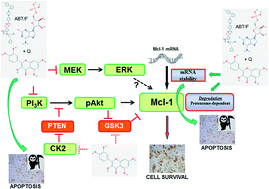The pleiotropic flavonoid quercetin: from its metabolism to the inhibition of protein kinases in chronic lymphocytic leukemia
Abstract
Quercetin is a flavonoid, of the subclass flavonols, possessing potential anticancer properties. It has often been defined as a functionally pleiotropic molecule because it can simultaneously target multiple pathways bypassing or ameliorating the onset of drug resistance in malignant cells. In this context, we reviewed the sometimes paradoxical antioxidant properties of quercetin and the functional role of its glucuronide and/or sulfate conjugates to discuss the low bioavailability of the molecule measured in vivo. We recently demonstrated that quercetin is able to sensitize several leukemia cell lines as well as B cells isolated from patients affected by chronic lymphocytic leukemia (CLL) to death ligand agonists (anti-CD95 and rTRAIL). The flavonol also potentiates the effect of canonical and innovative chemotherapeutic drugs (fludarabine and ABT-737) against CLL. The apoptosis-enhancing activity of quercetin in cell lines and B-CLL cells depends upon the modulated expression and activity of Mcl-1, an anti-apoptotic protein belonging to the Bcl-2 family. Herein, we suggest that the pleotropic activity of quercetin in CLL is obtained by the direct inhibition of key protein kinases, which positively regulate Mcl-1 activity and by indirect downregulation of Mcl-1 mRNA and protein levels acting on its mRNA stability and proteasome-mediated degradation. Finally, we highlighted the pros and cons of quercetin supplementation in cancer therapy and in prevention.

- This article is part of the themed collection: VI International Conference on Polyphenols and Health

 Please wait while we load your content...
Please wait while we load your content...